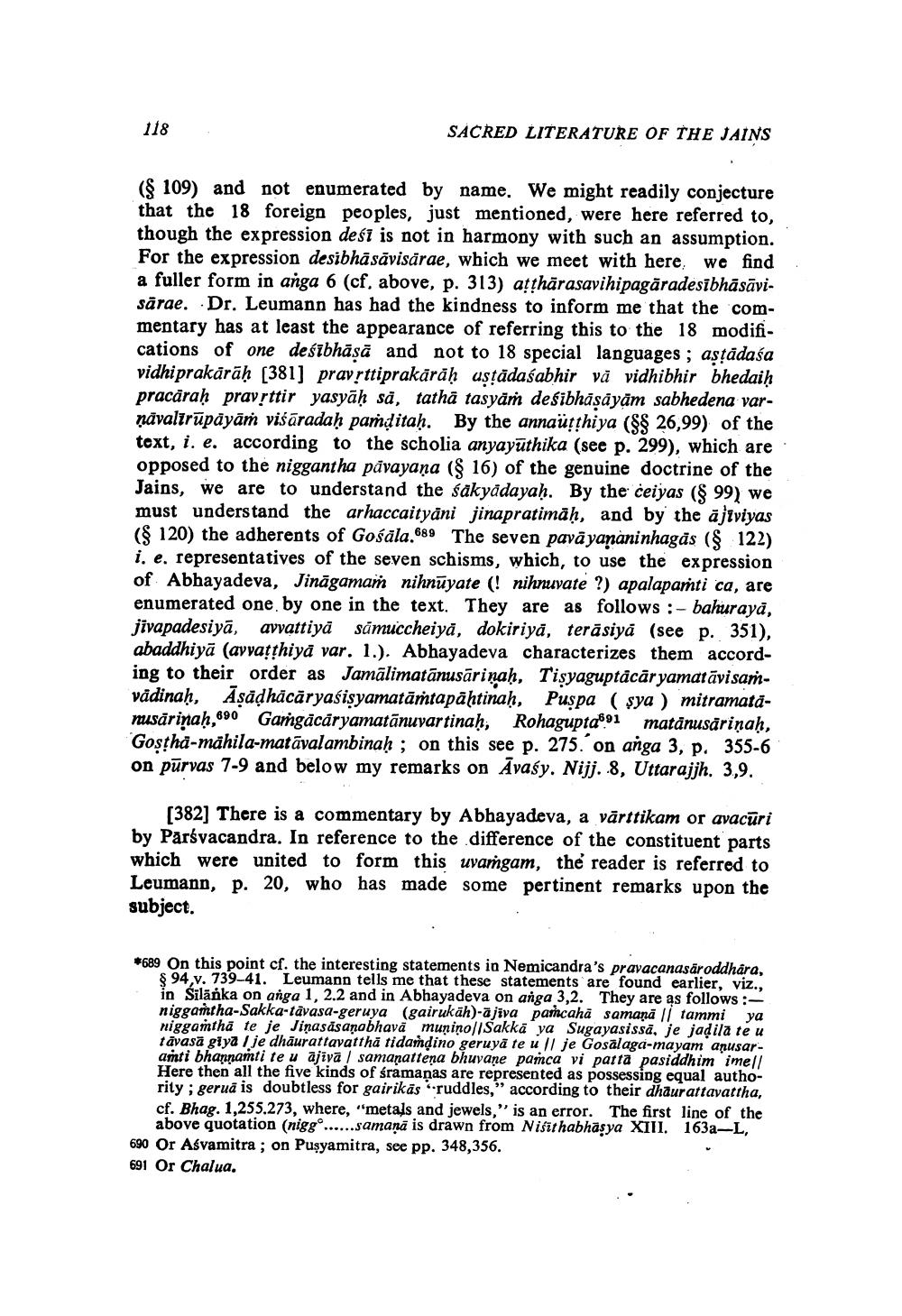________________
118
SACRED LITERATURE OF THE JAINS
($ 109) and not enumerated by name. We might readily conjecture that the 18 foreign peoples, just mentioned, were here referred to, though the expression desi is not in harmony with such an assumption. For the expression desibhāsāvisärae, which we meet with here, we find a fuller form in anga 6 (cf. above, p. 313) atthārasavihipagāradesībhāsāvisārae. Dr. Leumann has had the kindness to inform me that the commentary has at least the appearance of referring this to the 18 modifications of one desībhāsā and not to 18 special languages; astādaśa vidhi prakārāḥ [381] pravrttiprakārāḥ uştādaśabhir vă vidhibhir bhedaiḥ pracāraḥ pravșttir yasyāḥ sä, tathā tasyāṁ desibhāṣāyām sabhedena varņāvalirūpāyās visāradaḥ panditaḥ. By the annaütthiya (S$ 26,99) of the text, i. e. according to the scholia anyayüthika (see p. 299), which are opposed to the niggantha pāvayaņa (§ 16) of the genuine doctrine of the Jains, we are to understand the sakyadayaḥ. By the ceiyas ($ 99) we must understand the arhaccaityāni jinapratimāḥ, and by the äjiviyas ($ 120) the adherents of Gośāla.689 The seven pavāyananinhagas ( 122) i, e, representatives of the seven schisms, which, to use the expression of Abhayadeva, Jināgamań nihnūyate (! nihnuvate ?) apalapaṁti ca, are enumerated one by one in the text. They are as follows:- bahuraya, jivapadesiyā, avvattiyā sāmuccheiya, dokiriya, teräsiya (see p. 351), abaddhiyā (avvatthiya var. 1.). Abhayadeva characterizes them according to their order as Jamālimatānusārinaḥ, Tisyaguptācāryamatāvisamvădinaḥ, Āsādhācāryaśisyamatāṁtapāhtinaḥ, Puspa ( sya ) mitramatanusarinah,690 Gargācāryamatānuvartinah; Rohagupta691 matanusariņah, Gostha-mähila-matāvalambinaḥ; on this see p. 275. on anga 3, p. 355-6 on pūrvas 7-9 and below my remarks on Āvasy. Nijj..8, Uttarajjh. 3,9.
(382] There is a commentary by Abhayadeva, a vārttikam or avacūri by Parśvacandra. In reference to the difference of the constituent parts which were united to form this uvargam, the reader is referred to Leumann, p. 20, who has made some pertinent remarks upon the subject.
*689 On this point cf. the interesting statements in Nemicandra's pravacanasäroddhara,
$ 94, v. 739-41. Leumann tells me that these statements are found earlier, viz., in Silänka on anga 1, 2.2 and in Abhayadeva on anga 3,2. They are as follows: niggantha-Sakka-tavasa-geruya (gairukāh)-ājiva pañcahā samanā Il tammiya niggathā te je Jinasasanabhavă muniños/Sakkā ya Sugayasissä, je jadila te u tavasā giya Ije dhāurattavatthā tidaṁdino geruyā te u II je Gosalaga-mayam anusaranti bhannamti te u ajivā / samanattena bhuvane pamca vi parta pasiddhim imell Here then all the five kinds of śramaņas are represented as possessing equal authority ; gerua is doubtless for gairikās ruddles,” according to their dhaurattavattha, cf. Bhag. 1,255,273, where, "metals and jewels,” is an error. The first line of the
above quotation (niggo......samanā is drawn from Nisithabhasya XIll163-L, 690 Or Asvamitra ; on Puşyamitra, see pp. 348,356. 691 Or Chalua.




